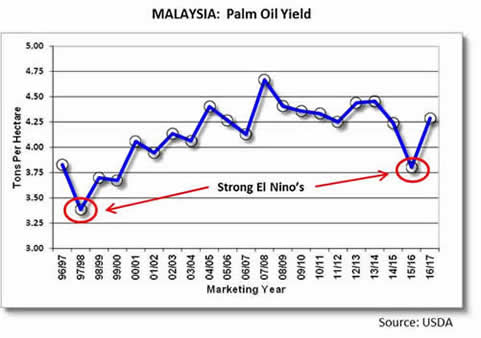MALAYSIA: El Nino Takes a Bite Out of 2015/16 Palm Oil Production
A strong El Niño weather pattern suppressed rainfall over a wide swath of southeastern Asia during 2015 and early 2016, causing drought-related yield losses for both food and plantation crops in most countries in the region. Rainfall in Malaysia’s prime palm oil growing areas in both eastern and western provinces was erratic and deficient between June 2015 and March 2016, resulting in a prolonged period of moderate drought stress. The greatest moisture deficits of the past year occurred between January and March of 2016, but were quickly followed by near-normal rainfall between May and July as the El Niño system began to weaken. Despite the recent improvement in precipitation, however, the damage has been done to the palm oil crop. USDA estimates 2015/16 production at 18.25 million metric tons, down 8 percent from 2014/15.

Oil palm trees are moisture sensitive in general and are primarily adapted to tropical regions with consistent year-round temperatures and rainfall. To yield normally, oil palms require between 150 to 200 millimeters of rainfall each month. This equates to roughly 2,000 to 2,500 millimeters per year. The trees can withstand short drought periods, depending on the soil type and underlying water table. Drought stress lasting more than 8 weeks, however, usually results in reduced flowering and fruit production during the subsequent 12-month period. Yield reductions can reach 30 percent following very severe drought. Palm oil yields typically decline 4 to 12 months after a stress event has occurred.
Based on monthly data released by the Malaysian Palm Oil Board (MPOB) it is apparent that palm oil production has been below average for 8 of the past 10 months of the current USDA 2015/16 marketing year (October 2015 through September 2016) and that cumulative production is running about 1.0 million tons below normal for the period. Malaysian plantation officials have reported that drought stress has adversely impacted reproductive processes in the oil palm trees, resulting in low female flowering rates, reduced fresh fruit bunch (FFB) size and weight, and low oil content in the fruit.

The most significant negative impact in regional Malaysian 2015/16 palm oil yields and production appears to be occurring in Peninsular West Malaysia. Cumulative losses to date in these provinces reached 1.06 million tons in July compared to last year, and 0.98 million tons compared to the 5-year average. It should be noted that this same region experienced record-breaking rainfall and flooding last year, damaging transport infrastructure and palm oil processing mills and equipment. Harvest activities and crop output declined for a period of 3 months from December 2014 to February 2015. Plantations were just recovering from the floods in the March to May period in 2015 when El Niño drought conditions began to develop, so provinces in Western Malaysia actually experienced unprecedented back-to-back natural disasters during the past 18 months.

USDA estimates 2015/16 Malaysian palm oil production at 18.25 million metric tons, down 0.5 million from last month and down 1.63 million from last year. Harvested area is forecast at a record 4.8 million hectares, up 0.111 million hectares from last year. Yield is estimated at 3.80 tons per hectare, down 10 percent from last year and the lowest in the past 15 years. By comparison, yields fell approximately 12 percent in 1997/98 during the last severe El Niño which blanketed the region.
This report has been published by the Office of Global Analysis (OGA), International Production Estimates Division (IPAD). Current USDA area and production estimates for agricultural commodities are available on IPAD’s Agricultural Production page, or at PSD Online.
Related Links at FAS
MALAYSIA: 2014/15 Palm Oil Production Affected by Flooding
http://pecad.fas.usda.gov/highlights/2015/03/Malaysia/Index.htm
PSD Online
http://apps.fas.usda.gov/psdonline/psdQuery.aspx
Crop Explorer
Crop Explorer http://www.pecad.fas.usda.gov/cropexplorer/
|

